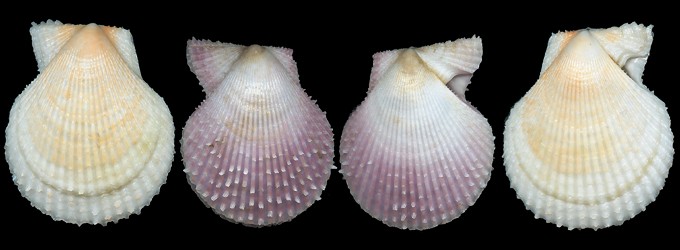UNUSUAL SHELLS

Traces of purple sometimes appear. 42mm, 51mm.

Rarer, the white shells with traces of orange or purple. 42mm, 48mm.
The purple colour is the rarest in this population, and always occurs in pale shells.
You notice that the bigger scallop had a colour when young and faded when older, while the purple one was white at juvenile stage and coloured later.
The purple colour is the rarest in this population, and always occurs in pale shells.
You notice that the bigger scallop had a colour when young and faded when older, while the purple one was white at juvenile stage and coloured later.

Rarest: the pure white shells (only one after two months of collecting). 37mm.
The umbos are actually white: their orange colour is due to a fine detritic dust cemented between the ribs. Notice that the colours of the dust and of the "orange" shell are the same. 38mm.
The umbos are actually white: their orange colour is due to a fine detritic dust cemented between the ribs. Notice that the colours of the dust and of the "orange" shell are the same. 38mm.
THE BRIGHT ORANGE FORM

Pale shells are always less common than deeper coloured ones. This rule remains true even inside such an uncommon form as the "aurantiaca" Clement. 42mm, 47mm.

Two average "aurantia" from the Bay of Quiberon.
As there is no clear transition between "aurantia" and any other varia, I believe that this name represents something noticeable, and must be preserved. I've more doubts with "purpurea" but nobody can propose such an opinion after having collected samples in a single area. Both shells are 41mm long.
As there is no clear transition between "aurantia" and any other varia, I believe that this name represents something noticeable, and must be preserved. I've more doubts with "purpurea" but nobody can propose such an opinion after having collected samples in a single area. Both shells are 41mm long.

Deep "aurantia". Such a colour is uncommon in this form, in the area. 42 & 47mm.
Most of the orange varia are broken or a little bit freak. It could be that the majority of those, who survived to predation when young, lived inside the mass of shells/debris/byssus which forms the bottom. This can be observed by simply snorkeling upon such shell reefs. Orange are scarce and hidden.
Most of the orange varia are broken or a little bit freak. It could be that the majority of those, who survived to predation when young, lived inside the mass of shells/debris/byssus which forms the bottom. This can be observed by simply snorkeling upon such shell reefs. Orange are scarce and hidden.
Two pictures from other collections:
Two shells from the western side of Quiberon bay
Two last pics:
An atra and a white/purplish shell